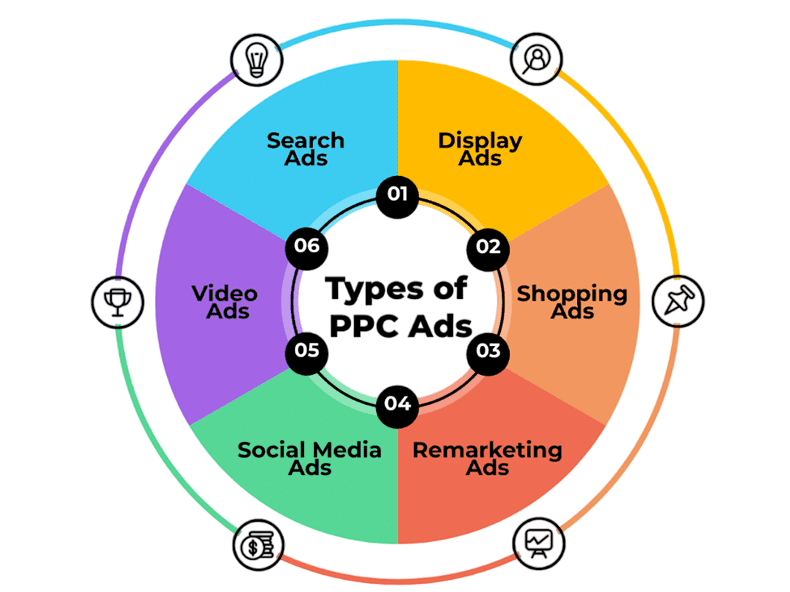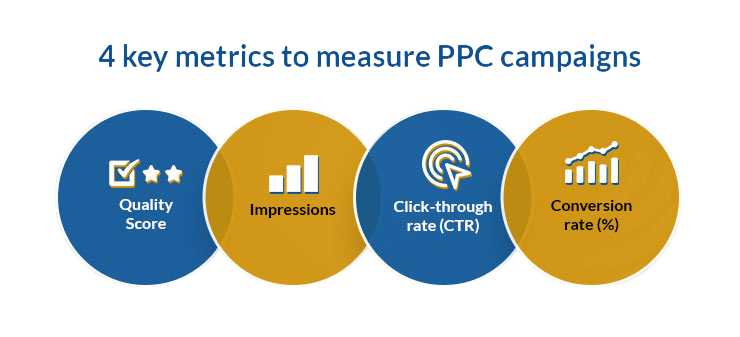
- Introduction to PPC
- What Does PPC Stand For?
- Types of PPC Advertising
- Key Components of a PPC Campaign
- Benefits of PPC in Digital Marketing
- Common PPC Platforms
- PPC vs. SEO: What’s the Difference?
- How to Create a Successful PPC Campaign
- Tools for Managing PPC Campaigns
- Measuring PPC Success: Important Metrics
- Conclusion
Introduction to PPC
In today’s digital marketing world, having visibility and getting quick results is crucial for businesses that want to succeed. One of the most effective strategies is PPC, which stands for Pay-Per-Click advertising a performance-driven model emphasized in Digital Marketing Training, where learners gain hands-on experience with keyword bidding, ad creation, and conversion tracking to drive targeted traffic, optimize ROI, and master paid media campaigns across platforms like Google Ads and Bing Ads. This method has become more popular because it can bring targeted traffic directly to a business’s website. With PPC, advertisers can pay for immediate exposure. This means they can start attracting potential customers right away. This differs greatly from organic marketing strategies, which often take more time and effort to produce results. By investing in PPC ads, companies can make sure that their products or services reach the right audience, leading to higher conversion rates.
Ready to Get Certified in Digital Marketing? Explore the Program Now Digital Marketing Online Training Offered By ACTE Right Now!
What Does PPC Stand For?
Pay-Per-Click, often called PPC, is a widely used online advertising model. In this setup, businesses pay a fee each time someone clicks on one of their ads. This method helps advertisers get traffic to their websites quickly, instead of only relying on organic visits, which can take longer to build. With PPC, companies can pick specific keywords that relate to their products or services and bid on them a pivotal innovation in the History & Evolution of Digital Marketing, where platforms like GoTo.com and Google AdWords revolutionized advertising by introducing auction-based keyword bidding, enabling businesses to target intent-driven search traffic and optimize ad placement for maximum ROI. When people search for those keywords, the company’s ads may show up in sponsored spots, usually at the top or side of search engine results pages. This lets businesses effectively target their audience since their ads appear only to users who are actively looking for related information. By investing in PPC, companies can improve their online visibility, draw more visitors to their websites, and increase their chances of turning those visitors into customers. PPC operates primarily on an auction system. Advertisers select keywords relevant to their products or services and bid on those keywords. When a user types a search query matching those keywords, an auction determines which ads appear and in what order, based on bid amount and ad quality. Advertisers only pay when a user clicks their ad, not when the ad is displayed. This means you only pay for actual traffic driven to your site.
Types of PPC Advertising
PPC is a broad term that covers several advertising formats:
- Search Ads: Ads displayed at the top or bottom of search engine results pages (SERPs) like Google or Bing.
- Display Ads: Banner ads shown on websites that participate in ad networks.
- Social Media Ads: Paid ads on platforms like Facebook, Instagram, LinkedIn, and Twitter.
- Remarketing Ads: Target users who previously visited your site to encourage conversions.
- Shopping Ads: Product listings shown on search engines like Google Shopping.
- Search Engine Optimization (SEO): SEO is the process of optimizing your website to rank higher on search engines like Google. It involves keyword research, on-page SEO (meta tags, content optimization), technical SEO (site speed, mobile-friendliness), and off-page SEO (backlinks). A strong SEO foundation improves organic visibility and drives free, targeted traffic.
- Content Marketing: Content marketing focuses on creating and distributing valuable, relevant content to attract and engage a clearly defined audience. Examples include blog posts, videos, infographics, and ebooks. Good content educates potential customers, builds trust, and supports other marketing channels like SEO and social media.
- Social Media Marketing (SMM): SMM uses platforms like Facebook, Instagram, LinkedIn, and Twitter to promote brands and engage users. Social media marketing involves organic posts, paid ads, influencer collaborations, and community management. It helps increase brand awareness, foster customer loyalty, and generate leads.
- Pay-Per-Click Advertising (PPC): PPC is a paid advertising model where marketers pay a fee each time their ad is clicked. Common platforms include Google Ads and social media advertising. PPC offers instant traffic, detailed targeting options, and clear ROI tracking. Ads can appear in search results, social feeds, or display networks.
- Email Marketing: Email marketing involves sending targeted messages to a subscriber list. It’s a direct channel for nurturing leads, promoting products, and maintaining customer relationships. Successful email campaigns use personalization, segmentation, compelling subject lines, and strong calls to action.
- Affiliate Marketing: Affiliate marketing allows businesses to partner with individuals or companies (affiliates) who promote their products in exchange for a commission on sales or leads. It leverages a wider network for growth and is performance-based, minimizing upfront marketing costs.
- Online Public Relations (PR): Online PR focuses on building a positive brand reputation through digital media. This includes managing reviews, press releases, influencer outreach, and responding to customer feedback on social platforms. Good PR improves brand trust and visibility.
- Google Ads: The most popular PPC platform, offering search, display, shopping, and video ads.
- Microsoft Advertising (Bing Ads): A cost-effective alternative with a different audience base.
- Facebook Ads: Highly detailed audience targeting on the world’s largest social network.
- Instagram Ads: Visual and engaging ads within the Instagram feed and stories.
- LinkedIn Ads: Target professionals and businesses with sponsored content and InMail.
- Twitter Ads: Promote tweets and accounts to boost visibility and engagement.
- Set Clear Goals: Define what you want clicks, leads, sales, or brand awareness.
- Conduct Keyword Research: Use tools like Google Keyword Planner to find relevant keywords.
- Create Engaging Ad Copy: Write clear, concise ads with strong calls to action.
- Optimize Landing Pages: Ensure landing pages are relevant, fast, and user-friendly.
- Set Your Budget: Decide how much to spend daily or monthly.
- Launch and Monitor: Keep an eye on performance and adjust bids, keywords, and ads as needed.
- Analyze and Optimize: Use data to improve your campaign continually.
- Google Ads Editor: Manage campaigns offline.
- SEMrush: Keyword research and competitor analysis.
- SpyFu: Competitor PPC strategies.
- WordStream: PPC management and optimization tools.
- Optmyzr: Automated PPC management.

To Explore Digital Marketing in Depth, Check Out Our Comprehensive Digital Marketing Online Training To Gain Insights From Our Experts!
Key Components of a PPC Campaign
Digital marketing consists of several interconnected disciplines, each playing a unique role from SEO and PPC to email automation, content strategy, and analytics all of which are reshaped by Digital Transformation, where marketers integrate AI, automation, and data-driven personalization to enhance agility, deepen customer engagement, and align every tactic with evolving business goals and consumer expectations.
Benefits of PPC in Digital Marketing
Digital advertising provides a unique chance to achieve immediate and targeted marketing results with great precision and control. By using advanced targeting options, businesses can effectively reach audiences based on specific demographics, interests, locations, and devices. This ensures that every advertising dollar is spent wisely for the greatest impact a precision strategy emphasized in Digital Marketing Training, where learners master segmentation techniques, behavioral analytics, and platform-specific targeting tools to optimize reach, reduce ad waste, and drive high-conversion engagement across digital campaigns. The platform offers flexible budgeting choices, allowing marketers to set daily or monthly spending limits, ensuring full financial transparency and control. Additionally, the tracking and measurement tools enable real-time performance evaluation. Brands can closely monitor every click and conversion with impressive detail. This data-driven approach not only supports quick campaign adjustments, but it also helps businesses boost brand awareness by consistently reaching new, relevant audiences. This turns digital advertising into a strong and measurable growth strategy.
Looking to Digital Marketing Training? Discover the Digital Marketing Expert Masters Program Training Course Available at ACTE Now!
Common PPC Platforms
PPC vs. SEO: What’s the Difference?
PPC, or pay-per-click advertising, is a method where you pay for ads that quickly bring visitors to your website. Once you decide to stop paying for these ads, the traffic stops immediately. This makes PPC a good choice when you need a quick boost in visitors or when promoting a special event a time-sensitive tactic explored in Learn Digital Marketing, where marketers discover how to launch event-driven campaigns, trend-jack emerging moments, and use keyword bidding to generate high-intent traffic and conversions within hours. In contrast, SEO, which stands for search engine optimization, focuses on improving your website’s ranking naturally over time. This method generates organic traffic without direct payments, but it takes more patience and ongoing effort to see significant results. Unlike PPC, the effects of SEO build slowly but can lead to a steady stream of visitors as your site rises in search engine results. When combined, PPC and SEO work well together, providing a balanced way to achieve maximum visibility online. While PPC delivers fast results, SEO provides long-term benefits. Using both can help your website attract a larger audience. Each has its own strengths, and together they can create a strong online presence for your brand.
Preparing for Digital Marketing Job Interviews? Have a Look at Our Blog on Digital Marketing Interview Questions and Answers To Ace Your Interview!
How to Create a Successful PPC Campaign
Tools for Managing PPC Campaigns
Measuring PPC Success: Important Metrics
In the fast-changing world of digital advertising, knowing key performance metrics is essential for improving marketing strategies a data-driven approach emphasized in Guide to YouTube Marketing, where marketers learn to track watch time, click-through rates, audience retention, and paid views to refine video content, optimize ad spend, and drive measurable results across YouTube campaigns. Click-Through Rate (CTR) shows the percentage of people who interact with your ad. Cost Per Click (CPC) tracks how much money you spend for each interaction.

The Conversion Rate is also important; it shows how well those clicks lead to the actions you want. Google’s Quality Score gives insights into ad relevance, helping marketers fine-tune their targeting and messaging. Return on Ad Spend (ROAS) is crucial for understanding how much revenue advertising generates and the financial effects of those efforts. Impression Share rounds out this performance picture by showing what portion of potential ad views your campaign gets. This information helps marketers assess and improve their overall digital advertising effectiveness.
Conclusion
PPC, or Pay-Per-Click advertising, is a useful tool that helps businesses reach specific audiences quickly and affordably. When done right, PPC campaigns can deliver clear returns on investment (ROI), improve brand recognition, and closely match broader marketing goals. As digital technology evolves and online platforms change, PPC will continue to be a major part of digital marketing strategies a future-proof tactic emphasized in Digital Marketing Training, where learners gain expertise in campaign setup, bid strategy, and ROI tracking to adapt paid media efforts across emerging tools, shifting user behaviors, and platform innovations. This approach combines creative ideas with data insights and automated processes, allowing marketers to connect with the right users at the perfect moment. By taking advantage of PPC, businesses can improve their overall marketing efforts and remain competitive in a fast-changing market. Effective PPC advertising is not just about increasing traffic; it’s about attracting the right kind of traffic that can lead to conversions and long-term customer relationships.




